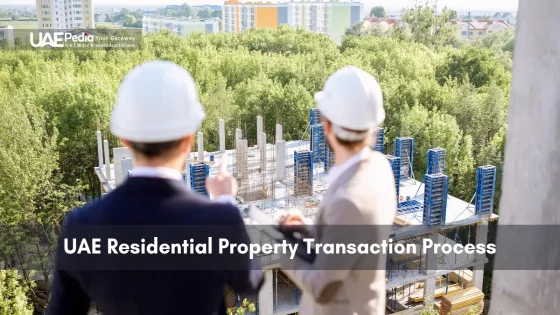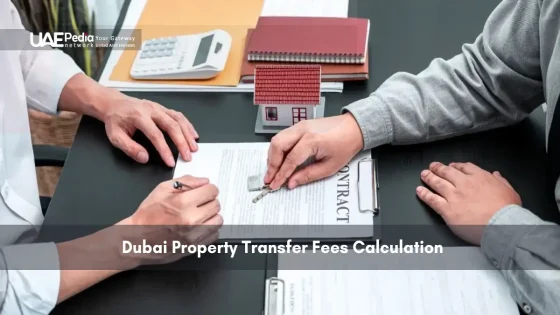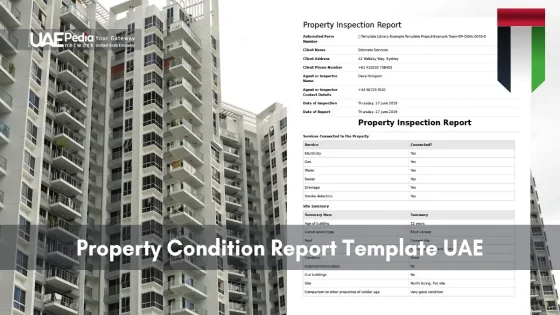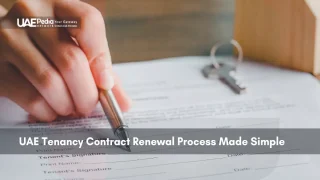Did you know over 80% of lease agreements in the UAE’s busiest city follow guidelines set by a single regulatory tool? As the region evolves, so do its housing policies—and staying informed matters whether you’re signing a contract or renewing one.
Dubai registered more than 900,000 tenancy contracts in 2024, and all new leases now reference the Smart Rental Index 2025 launched on 2 January 2025.
Understanding how annual adjustments work protects everyone involved. Tenants gain clarity on fair pricing, while property owners ensure compliance with local laws. This balance keeps communities thriving and avoids unnecessary disputes.
We’ll walk through the essentials together—from decoding official guidelines to using the updated digital tools launching next year. You’ll learn how to check rates confidently and prepare for the upcoming Smart Rental Index 2025, designed to simplify the process further.
The Dubai Rental Increase Calculation Formula standardizes annual rent adjustments by comparing existing lease rates against neighborhood benchmarks and predefined regulatory caps. Since January 2, 2025, the Smart Rental Index generates AI-driven, near real-time snapshots—updated monthly—to establish baseline rates, demand-shift trends, and maximum permissible increases as set by Decree 43 of 2013 and its March 2024 update. This transparent framework ensures tenants receive clear pricing metrics while landlords remain compliant with RERA guidelines.
RERA enforces a 90-day notice period for any rent change and provides an online calculator for rapid compliance checks. Users select property type, location, and current annual rent; the system cross-references this data with live market values to calculate allowable adjustments. Disputes exceeding caps are handled through the Rental Dispute Settlement Centre, promoting consistency and reducing conflicts.
Here’s what we’re covering:
- Why transparent pricing benefits all parties.
- How regulatory tools determine adjustments.
- Step-by-step guidance for current and future systems.
- Real-world scenarios to test your knowledge.
- 90-day notice rule for any rent change.
- How to file a case with Dubai’s Rental Dispute Settlement Centre (RDSC).
Landlords must issue a 90-day written notice before any rent adjustment; failure invalidates the increase. Ref.: “Travel’s Dubai. (2025). New rules: Dubai landlords must give 90-day notice before increasing rent. Travel’s Dubai.” [!]
Overview of Dubai Rental Increase Calculation Formula
Imagine a scale where fairness tips the balance. The system guiding annual price adjustments works like that—comparing existing agreements to neighborhood trends. Think of it as a GPS for housing costs: it recalculates routes when market conditions shift.
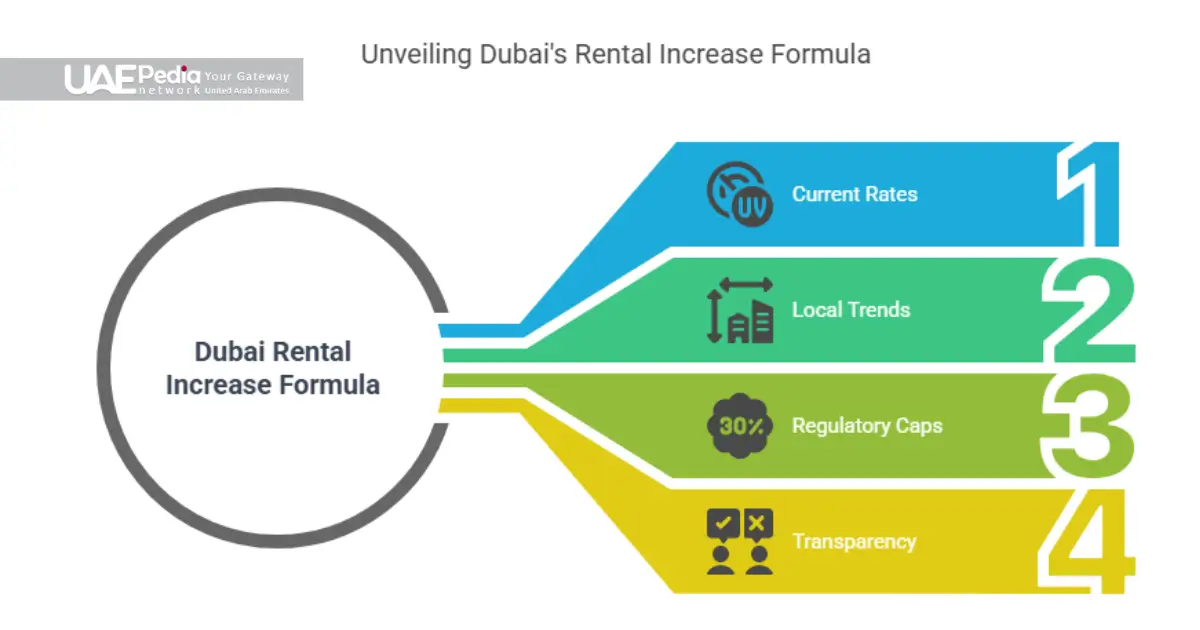
Since 2025 the index is generated with AI and updated in near real-time, giving monthly snapshots rather than annual ones.
| Factor | Role | Source |
|---|---|---|
| Current Rates | Baseline for comparison | Lease agreements |
| Local Trends | Reflect demand shifts | Quarterly surveys |
| Regulatory Caps | Set maximum rent increase limits | Public guidelines |
Caps are set by Decree 43 of 2013 and reaffirmed in the March 2024 update.
Transparency here acts like sunlight—it prevents disputes before they sprout. When everyone sees how numbers connect to the real estate market, conversations stay grounded. This clarity helps tenants budget smarter and owners avoid overstepping real estate regulatory boundaries.
Why does this matter? Knowing the rules lets you spot red flags early. For example, if your building’s rates jump 10% but nearby units only rise 5%, the formula’s math becomes your backup. Tools like the upcoming Smart Index will automate these checks, but the core principle remains: data-driven fairness.
In short, the system isn’t about winners or losers. It’s about aligning costs with community rhythms—so neighborhoods grow without leaving anyone behind.
RERA Enforcement Duties Shaping Dubai Rentals
Think of a referee in a high-stakes game—keeping play fair without slowing the action. That’s RERA in the Emirates’ property scene. Since 2007, this agency has shaped how communities grow by balancing owner returns with resident budgets.
RERA’s 2024-25 roadmap aligns with Dubai Real Estate Sector Strategy 2033, prioritising data-driven transparency.
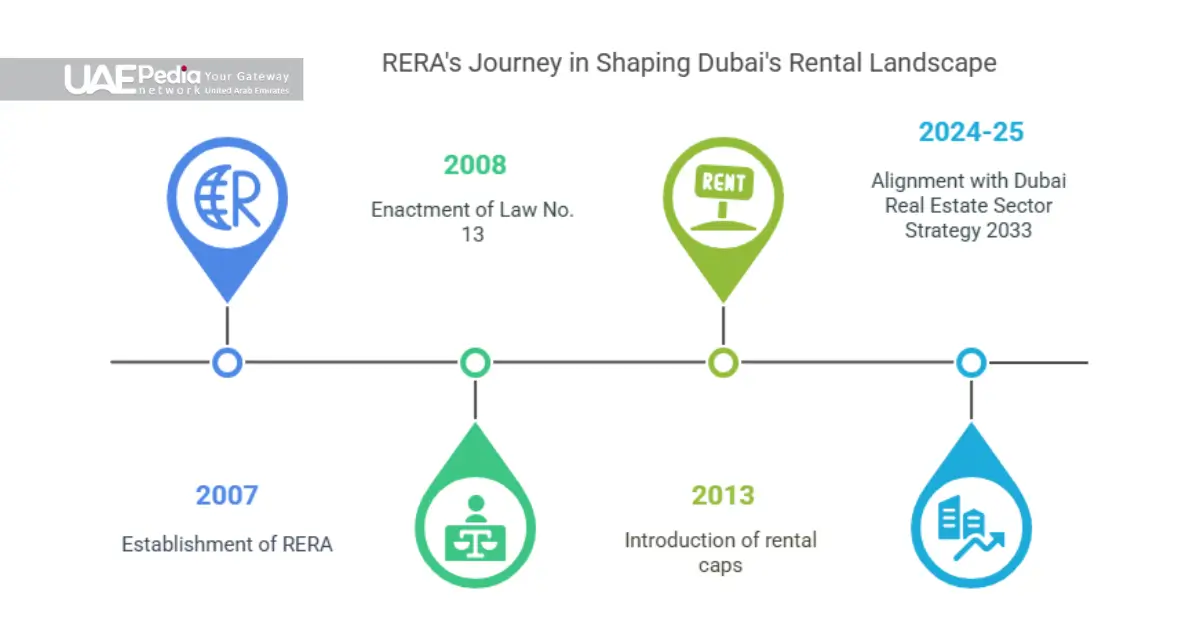
Core Mandate of RERA in Dubai
Born from Law No. 13 in 2008, RERA operates under the Dubai Land Department as the rulebook keeper for property dealings. It’s like a traffic light system: green for smooth negotiations, red for overstepping boundaries. Their guidelines help landlords verify current annual rent against neighborhood averages, ensuring no one pays outdated rates.
Impact on Rental Regulations
Remember 2013? That’s when RERA introduced caps to prevent sudden jumps in housing costs—a game-changer for stability. Today, their rental index acts as a shared compass, updated annually to reflect market shifts. Tools like RERA’s online calculator turn complex math into quick checks, whether you’re renewing a lease or challenging an unfair adjustment.
| Function | Purpose | Since |
|---|---|---|
| Maximum Adjustment Caps | Prevent sudden cost spikes | 2013 |
| Annual Benchmark Reports | Guide fair pricing | 2008 |
| Dispute Resolution | Mediate disagreements | 2007 |
This system isn’t just about rules—it’s about trust. Tenants gain negotiating power, while owners avoid legal headaches. Together, these efforts keep the market thriving without leaving anyone feeling sidelined.
Read More:
Key Variables Driving Dubai Rent Formula
Picture your lease agreement as a recipe—specific ingredients combine to determine fair adjustments. The system blends your property’s unique traits with neighborhood trends to create balanced outcomes. Let’s unpack how this mix works.
| Ingredient | Purpose | Example |
|---|---|---|
| Location | Sets regional benchmarks | Downtown vs. suburban areas |
| Property Type | Defines category standards | 1-bed apartment vs. villa |
| Square Footage | Adjusts for size differences | 800 vs. 1,200 sq.ft units |
Here’s where it gets practical. If your current rate sits 20% below similar units, the adjustment percentage rises—but never beyond regulatory caps. Conversely, rates matching market averages see smaller changes. One resident we spoke with shared:
“When I checked my building’s standing, I realized my apartment was priced 15% under nearby listings. The 5% adjustment felt fair—it closed the gap without shock.”
Decree 43 of 2013—and all later guidance, including the 2024 refresh—still limits an increase to 5 % when the rent is 11 %-20 % below the index, and 0 % when the gap is 10 % or less. There is no 7 % bracket in the current law.
Let’s break this down with numbers:
- Scenario A: Current AED 80,000 vs. market AED 100,000 → 5 % increase allowed
- Scenario B: Current AED 95,000 vs. market AED 100,000 → no increase permitted
Always verify your unit’s classification through official channels. A quick check of your contract’s property size and type prevents mismatches. The upcoming Smart Index will automate these comparisons, but understanding the logic now prepares you for smoother renewals.
How Dubai Rent Increase Calculator Functions
Think of this tool as a fitness tracker for your lease agreement—it measures vital stats to keep your housing costs healthy. Whether you’re a first-time user or a seasoned pro, the process feels like solving a puzzle with clear edges.

Step-by-Step Rental Calculator Workflow
Let’s break it down like assembling flat-pack furniture—one piece at a time:
- Choose Your Coordinates: Start by selecting your property type (apartment, villa) and neighborhood. This sets the stage for accurate comparisons.
- Input Current Rates: Enter your existing annual payment. Pro tip—have your lease agreement handy to avoid typos. The 2025 update auto-imports your Ejari number, removing manual area selection.
- Let the Tool Work: The system cross-references your details with market value data from similar units nearby. Within seconds, you’ll see if adjustments fall within legal limits.
Essential Data Inputs for Accurate Results
Accuracy matters here—like baking with precise measurements. Essential details include:
- Exact square footage (no ballpark estimates)
- Year of last major renovation
- Amenities that impact value (pool access, parking spots)
See how small changes matter? If your neighbor’s identical unit lists 1,100 sq.ft instead of your 1,000, their permitted rent increases might differ by 2-3%. One resident shared:
“Updating our balcony size in the calculator changed the outcome—proof that details matter!”
Landlords and tenants both benefit from this clarity. It transforms guesswork into actionable insights, helping everyone stay aligned with community standards. Ready to try it? The digital tool awaits—no math degree required.
Setting Up Your Current Rent and Property Details
Ever tried assembling a puzzle without checking the box image first? Preparing your lease details works the same way—every piece matters. Start by gathering your contract expiry date, annual rent, and specifics like bedroom count. These form the foundation for accurate comparisons.
Determining Accurate Rental Index Values
Think of your property type as the first puzzle edge. A studio apartment won’t match villa benchmarks, just as beachfront units differ from inland homes. Inputting precise square footage and amenities ensures the system reflects your unit’s true standing.
| Property Type | Key Details | Impact on Index |
|---|---|---|
| 2-Bed Apartment | Built-in wardrobes, balcony size | +3-5% value |
| 3-Bed Villa | Private garden, maid’s room | +7-10% value |
One resident shared:
“Listing our 2022 kitchen renovation cut our proposed adjustment by 4%—details matter!”
Verify your data through the local land department’s portal. Enter your contract number to cross-check listed features against public records. Discrepancies? Update them before calculations. Log in with your Ejari certificate on the DLD portal to verify unit data before calculations. DLD rental-index e-service. (dubailand.gov.ae)
Why stress over market trends? If your area’s average for similar units jumps 8% but your setup shows outdated specs, you might overpay. Aligning your details with current realities helps everyone make informed decisions—like knowing when to negotiate or accept adjustments gracefully.
Market Value Drivers Affecting Dubai Rents
Ever watched a stock ticker? Market value works similarly—constantly adjusting to neighborhood buzz and demand shifts. It’s the pulse of the rent market, reflecting what similar properties fetch today. Think of it as a live feed: when new cafes open or transit lines expand, values rise like trending shares.

Prime spots naturally command higher prices. Waterfront units or homes near metro stations often sit 15-20% above suburban counterparts. But here’s the twist: your current market rate acts as an anchor. Knight Frank reports that 27 000 new residential units were completed in 2024, tempering mid-range rent growth to about 4 % city-wide.
| Factor | Impact on Value | Example |
|---|---|---|
| Location | High-demand areas add premium | Downtown vs. industrial zones |
| Amenities | Modern upgrades boost appeal | Gym access, smart home tech |
| Demand Trends | Seasonal shifts affect pricing | School year vs. summer leases |
Consider two units in the same building:
- Unit A: AED 90k/year vs. AED 110k market value → 7% maximum rent adjustment
- Unit B: AED 105k/year vs. AED 110k market value → 2% adjustment
One tenant shared:
“Tracking our area’s new park construction helped us anticipate—and budget for—next year’s hike.”
Landlords avoid vacancy risks by aligning with rent market rhythms, while tenants gain negotiation leverage. Staying updated? Check quarterly reports or set alerts for neighborhood developments. Knowledge turns rent adjustments from surprises into planned next steps.
Legal Rules Governing Dubai Rent Increases
Think of lease agreements as a dance floor—there are steps everyone must follow to keep the rhythm smooth. Knowing your legal footing helps avoid missteps. Let’s explore the rules that keep housing costs fair and disputes rare.

Rules of the Road
Local guidelines act like guardrails. Property owners must give 90 days’ notice before adjusting costs—no surprises allowed. This rule, part of the 2013 estate regulatory update, ensures tenants have time to budget or negotiate.
| Requirement | Details | Penalty for Violation |
|---|---|---|
| Notice Period | 90 days before renewal | Invalid increase |
| Cap Compliance | Must follow RERA Smart Rental Index brackets | AED 20 000 (first offence) → up to AED 50 000 for repeat or severe breaches |
| Documentation | Written notice required | Case dismissal |
Under the Real Estate Violation System, RERA may escalate fines to AED 50 000 when landlords repeatedly ignore notice-period or cap-compliance rules.
Dubai Land Department announcement on AED 50 000 fines for non-compliance with RERA directives (dubailand.gov.ae)
With accuracy targets above 90 %, any data-feed disruption or AI model latency could lead to incorrect rent benchmarks. Ref.: “Gulf News. (2025). Dubai’s all‐new digital rental index to go live with new building classification. Gulf News.” [!]
One resident shared their win:
“When my landlord skipped the notice period, RERA canceled the hike. Knowledge truly is power!”
Dispute Steps When Rent Figures Conflict
Spotting an unfair adjustment? First, cross-check using the official calculator. If your current annual payment aligns with the estate market average but the proposed hike exceeds caps, gather your lease and communications.
Here’s your action plan:
- Request written justification from the property owner
- File a dispute through RERA’s online portal within 30 days
- Attach your calculator results as evidence
Staying updated on estate regulatory changes helps you make informed choices. Bookmark RERA’s annual reports and set calendar reminders for lease renewals. When in doubt, consult a local housing advisor—they’ll help you navigate the estate market with confidence.
Transitioning to the Smart Rental Index in 2025
What if your lease agreement could update itself like a smartphone? That’s the vision behind the Smart Rental Index 2025—a game-changing upgrade to how communities balance housing costs. This new system swaps annual snapshots for real-time insights, creating fairer outcomes for everyone involved.
The Smart Rental Index went live on 2 January 2025, replacing the legacy rental-increase calculator. It uses AI for predictive pricing, delivering real-time benchmarks based on live contract data.
Unlike the previous calculator Dubai tool, which relied on quarterly surveys, the Smart Index analyzes live market shifts. Think of it as shifting from black-and-white TV to 4K streaming—suddenly, every detail matters. AI spots patterns humans might miss, like how new schools or transit lines affect demand within weeks, not months.
| Feature | Previous System | Smart Index 2025 |
|---|---|---|
| Data Sources | Quarterly reports | Real-time transactions |
| Adjustment Logic | Fixed formulas | AI-driven predictions |
| Transparency | Annual public reports | Live dashboards for all |
For tenants and owners, this means quicker responses to current market realities. Imagine knowing exactly how your building’s new gym affects values—or why a nearby park project caps adjustments. One property manager shared:
“We’re excited to show residents clear cause-and-effect relationships. It builds trust before tough conversations.”
Ultimately, this shift isn’t just about better math—it’s about fairness transparency you can see in action. When both parties share the same data, negotiations focus on facts, not fears. And that’s how communities grow stronger, one balanced agreement at a time.
Practical Strategies to Navigate Rent Hikes
Navigating rent discussions can feel like preparing for a friendly chess match—strategy matters more than strength. Arm yourself with facts, not frustration. How to turn tough talks into win-win outcomes.
Proven Data-Driven Rent Negotiation Strategies
Start by treating the conversation like a collaborative puzzle. Property owners often appreciate tenants who approach adjustments thoughtfully. One resident shared:
“Bringing a Smart Rental Index PDF export changed the tone instantly and kept the discussion focused on current data. We agreed on a 3% hike instead of 5% by comparing our current rental to similar units.”
| Strategy | Purpose | Example |
|---|---|---|
| Gather Comparable Data | Anchor discussions in reality | Check 2-bed units with pool access |
| Highlight Long-Term Value | Show stability benefits | Offer 18-month lease for smaller increase |
| Use Official Tools | Validate claims objectively | Share RERA calculator results |
Notice how rental values for identical number bedrooms can vary? A building with newer gym equipment might justify higher rates—but outdated units shouldn’t match those prices. Prepare your counterpoints:
- Attach the latest Smart Rental Index PDF export for your unit and community.
- Note maintenance requests fulfilled promptly.
- Suggest phased adjustments if sudden hikes strain your budget.
- Bring evidence that the landlord sent—or failed to send—the mandatory 90-day written notice of any rent change.
Remember—the goal isn’t to “win” but to find middle ground. Maybe your landlord values timely payments over maxing out rental values. One creative solution we’ve seen: tenants offered to handle minor repairs in exchange for freezing rates.
Keep conversations factual but friendly. Phrases like “Let’s review the dubai rest averages together” build trust. And always double-check that number bedrooms and square footage in your lease match public records—it’s your right!
Leveraging Calculator Data for Rent Decisions
Imagine having a GPS for housing costs—one click reveals whether your next move aligns with community standards. The official calculator does exactly that, turning complex regulations into clear insights. Let’s explore how to use this tool like a pro.
Accessing the Tool on the DLD Website
Start your journey at the Dubai Land Department portal—it’s simpler than ordering takeout. Here’s how:
- Visit dubailand.gov.ae and click “Services”
- Select “Rental Dispute” > “Rental Increase Calculator”
- Choose between residential or commercial properties
Prefer mobile? The Dubai REST app mirrors these steps. One user shared:
“I found the app version faster—saved my results as PDF for later talks.”
| Access Method | Key Features | Best For |
|---|---|---|
| Website | Detailed reports | Desktop research |
| Mobile App | Quick checks | On-the-go updates |
Interpreting Calculator Results for Compliance
Your screen will display two critical numbers: current index value and permitted adjustment range. If the tool shows a 5-7% increase cap but your landlord proposes 9%, red flags wave. Always cross-check these against the index updated quarterly.
Three quick verification tips:
- Confirm your property’s square footage matches official records
- Compare results with 2-3 similar units in your area
- Note the “last updated” date—systems refresh annually
Why does this matter? The updated annually data reflects real-time market shifts. A resident in Jumeirah recently avoided a 12% hike by proving their building’s index hadn’t changed since 2023. Knowledge truly is power here.
Armed with these steps, you’re ready to navigate housing costs confidently. Whether challenging unfair adjustments or planning future budgets, the calculator becomes your trusted co-pilot.
The Benefits of Transparency in Dubai’s Real Estate Market
Clear skies make for smooth flights—and clear data makes for fair housing deals. When everyone sees the same numbers, trust grows naturally. This openness transforms tense negotiations into collaborative problem-solving, creating wins for both sides.
Transparency acts like a shared playbook. Owners gain confidence their pricing aligns with market trends, while residents understand adjustments aren’t arbitrary. One property manager noted:
“Since using the official calculator, 80% of our renewals happen without back-and-forth. The numbers speak clearly.”
Consider a recent case where two neighbors faced different outcomes. The first checked their unit’s standing using public tools and negotiated a 3% hike. The second didn’t—and paid 7% more for a similar space. Knowledge gaps cost real money.
| Factor | Impact on Trust |
|---|---|
| Clear Data Access | Reduces suspicion |
| Open Communication | Builds partnership |
| Third-Party Tools | Validate claims fairly |
Local authorities play referee here. By mandating standardized reporting and real estate benchmarks, they ensure no one corners the market. Annual reports and live dashboards let everyone track shifts together—like watching weather patterns before planning a picnic.
Live dashboards became available to the public in Q1 2025 on dubailand.gov.ae.
Ultimately, transparency isn’t just about rules. It’s about creating a marketplace where decisions feel predictable, not puzzling. When both sides share the same facts, communities thrive on mutual respect rather than missed opportunities.
Check out the below:
Final Takeaways for a Successful Rental Experience
Navigating housing costs works best with the right tools and trust. Whether you’re reviewing a lease or planning future budgets, these insights help create fair outcomes for everyone.
RERA’s guidelines act like a compass—guiding landlords on compliant adjustments while giving tenants clear benchmarks. The official calculator remains your go-to for verifying numbers, transforming guesswork into actionable data. Pair this with open communication to turn tense talks into collaborative solutions.
Three quick reminders:
- Always cross-check proposed changes against current property values
- Mark your calendar for 90-day notice periods and renewal deadlines
- Bookmark updates about the 2025 Smart Index for real-time insights
Staying informed isn’t just smart—it’s empowering. Tools evolve, but the core principle remains: transparency builds stronger communities. Now you’re equipped to approach agreements with confidence, knowing how to advocate fairly while respecting local rhythms.
Ready to put this into practice? Your next housing decision just became clearer.
RERA’s Rental Index sets clear benchmarks based on property type, location, and amenities. If your current rent is below the average market value for similar units, landlords can only raise it by a capped percentage (5–20%) every 12–24 months. Always cross-check using their official calculator before agreeing to adjustments.
You can file a complaint with the Dubai Land Department’s Rental Dispute Center. Keep copies of your contract, the RERA calculator results, and any written notices. Illegal increases are unenforceable—don’t pay until the issue is resolved through official channels.
Absolutely! Use the Rental Index to compare your unit’s features (like parking, gym access, or balcony space) against similar properties. Present this data to your landlord—many prefer retaining reliable tenants over risking vacancies. Propose a middle ground that aligns with market fairness.
RERA refreshes the index annually to reflect shifts in supply, demand, and neighborhood development. Major updates in 2025 will introduce AI-driven valuations through the Smart Rental Index, offering real-time adjustments for hyperlocal trends like new metro lines or school openings.
Yes, but the calculator factors in furniture quality and appliance brands. If your lease includes high-end furnishings, ensure this is noted in your Ejari registration. Unfurnished units typically have lower baseline values, affecting the maximum allowable hike percentage.
Visit the DLD’s website or use the Dubai REST app. Input your contract details, property size, and exact location. The tool instantly shows if a proposed hike aligns with RERA guidelines—print or screenshot the results as evidence during negotiations.

